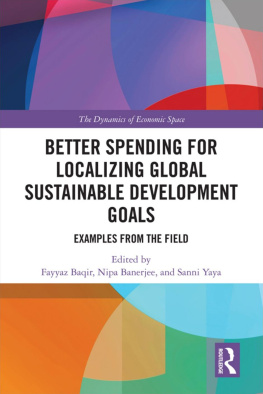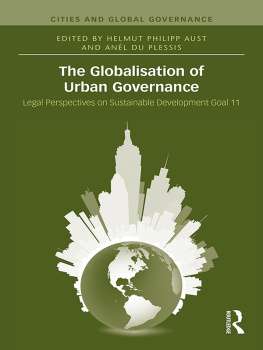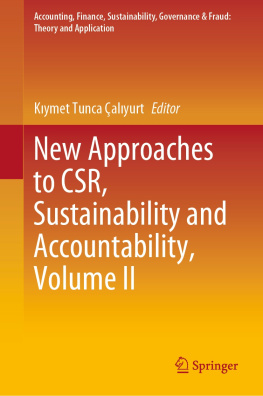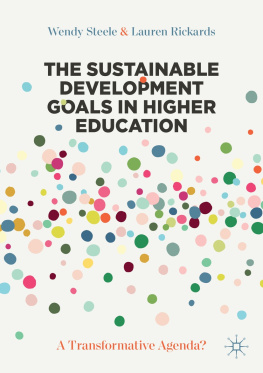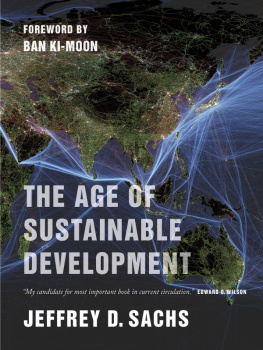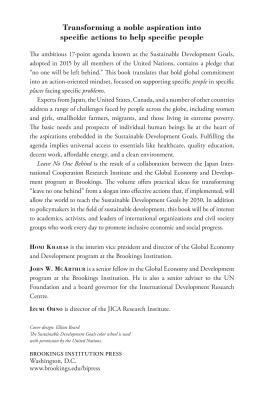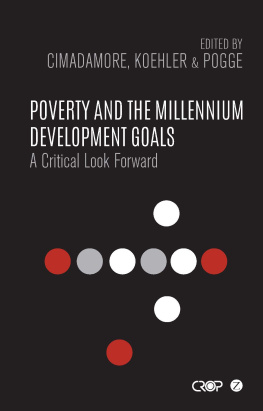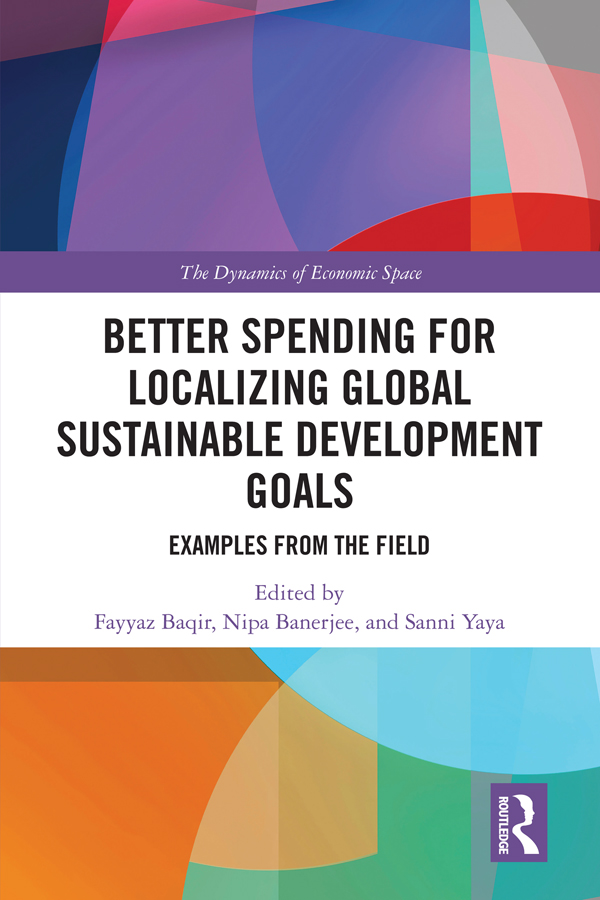
Better Spending for Localizing Global Sustainable Development Goals
This book centres around an intense debate among donors, policymakers, development practitioners, and academics on the efficacy of aid in eradicating poverty while promoting human development.
It seeks to fill the gap in present literature by presenting stories of better spending through implementing Sustainable Development Goals and addressing Agenda 2030 via indigenization of global development goals with initiatives at local and national levels. The book adopts an innovative approach to dealing with aid effectiveness by highlighting the relevance of better spending, rather than excessive spending. It does so with real-life examples of interventions made in the Global South to realize the vision of thinking globally and acting locally. These case studies speak to the significance of communities role in shouldering responsibility for planning, financing, operating, and maintaining local developmental initiatives. The examples also demonstrate how aid serves its purpose when used as an investment in communities and enterprising individuals, in order to realize the strategic impact of giving and build a local receiving mechanism for indigenizing and achieving global development goals.
The book references cases of better spending by governments, philanthropists, and civil society organizations (CSOs) from across Asia, Africa, and Latin America on a range of issues and will, thus, be of interest to development practitioners, policymakers, donors, philanthropists, civil society organizations, and academics and students of international development studies.
Fayyaz Baqir is a visiting scholar at the University of Ottawa. He served as Senior Advisor on civil society at the United Nations, and CEO of Trust for Voluntary Organizations. He received top contributors awards from UNDPs Global Poverty Reduction Network.
Nipa Banerjee has a PhD from the University of Toronto in development studies and has served for over 40 years as an international development practitioner, policy analyst and advisor, and professor, at different periods of her career. Her experience includes 34 years with CIDA, Canadas former ODA agency, notably as head of mission in Thailand, Cambodia, Laos, and Afghanistan and as Counselor Development representing CIDA in Bangladesh, Indonesia and India.
Sanni Yaya is Full Professor of economics and global health, and Director and Associate Dean of the School of International Development and Global Studies. His work focuses on a broad array of multidisciplinary topics in development and global health.
The Dynamics of Economic Space
Series Editor: Nuri Yavan
Ankara University, Turkey
The IGU Commission on The Dynamics of Economic Space aims to play a leading international role in the development, promulgation and dissemination of new ideas in economic geography. It has as its goal the development of a strong analytical perspective on the processes, problems, and policies associated with the dynamics of local and regional economies as they are incorporated into the globalizing world economy. In recognition of the increasing complexity of the world economy, the Commissions interests include industrial production; business, professional, and financial services, and the broader service economy including e-business; corporations, corporate power, enterprise, and entrepreneurship; and the changing world of work and intensifying economic interconnectedness.
Making Connections
Technological Learning and Regional Economic Change
Edited by Edward J. Malecki and Pivi Oinas
Regional Change in Industrializing Asia
Regional and Local Responses to Changing Competitiveness
Edited by Leo van Grunsven
Interdependent and Uneven Development
Global Local Perspectives
Edited by Michael Taylor and Sergio Conti
The Industrial Enterprise and its Environment
Spatial Perspectives
Edited by Sergio Conti, Edward J. Malecki and Pivi Oinas
Towards Coastal Resilience and Sustainability
Edited by C. Patrick Heidkamp and John Morrissey
Better Spending for Localizing Global Sustainable Development Goals
Examples From the Field
Edited by Fayyaz Baqir, Nipa Banerjee and Sanni Yaya
For more information about this series, please visit: www.routledge.com/The-Dynamics-of-Economic-Space/book-series/ASHSER1030
First published 2020
by Routledge
2 Park Square, Milton Park, Abingdon, Oxon OX14 4RN
and by Routledge
52 Vanderbilt Avenue, New York, NY 10017
Routledge is an imprint of the Taylor & Francis Group, an informa business
2020 Fayyaz Baqir, Nipa Banerjee and Sanni Yaya
The rights of Fayyaz Baqir, Nipa Banerjee and Sanni Yaya to be identified as the authors of this work have been asserted by them in accordance with sections 77 and 78 of the Copyright, Designs and Patents Act 1988.
All rights reserved. No part of this book may be reprinted or reproduced or utilised in any form or by any electronic, mechanical, or other means, now known or hereafter invented, including photocopying and recording, or in any information storage or retrieval system, without permission in writing from the publishers.
Trademark notice : Product or corporate names may be trademarks or registered trademarks, and are used only for identification and explanation without intent to infringe.
British Library Cataloguing-in-Publication Data
A catalogue record for this book is available from the British Library
Library of Congress Cataloging-in-Publication Data
A catalog record for this book has been requested
ISBN: 978-0-367-33845-9 (hbk)
ISBN: 978-0-429-32232-7 (ebk)
Typeset in Times New Roman
by Apex CoVantage, LLC.
Dedicated to young minds striving to beat scarcity in the age of abundance
Figures
2.1 Identifying and prioritizing development operations
4.1 First Dialogue Sherqila (1982)
4.2 RGMVP Womens Group
4.3 Addressing 17th Annual Session of Sustainable Development at UN General Assembly (2009)
6.1 Nazir Ahmad Wattoo (second from left) and Dr. Shujaat Ali, provincial secretary (third from left) launching the Bhalwal programme
10.1 Comparison in the joint distribution of deprivations in communities A and B
10.2 Deprivations in each indicator
10.3 Contribution of indicators to the PAMPI
10.4 Households deprivation in X% or more of the weighted indicators
10.5 Proportion of poor households across different indicators
10.6 Percentage contribution to PAMPI
11.1 Proportion of rural population with access to improved water supply in SSA
11.2 Proportion of urban population with access to improved water supply in SSA
11.3 Proportion of rural population with access to improved sanitation in SSA
11.4 Proportion of urban population with access to improved sanitation in SSA
11.5 Ratio of ODA disbursements for water and sanitation to total ODA
11.6 Commitments and disbursements to water and sanitation in SSA
11.7 Share of total gross ODA disbursement to water and sanitation in SSA (20022017) by project typology
11.8 Trend of gross ODA disbursement to water and sanitation in SSA over the period of 20022017, by project typology
11.9 Household data, SDG regions, subSaharan Africa, service levels
11.10 Household data, Democratic Republic of the Congo, service levels
11.11 Proportion of rural and urban population with access to improved water supply and sanitation in the DRC
12.1 Cereal food aid shipment and cereal production in Ethiopia between 1993 to 2015
12.2 Cereal food aid shipment as a percentage of cereal production in Ethiopia
Next page
